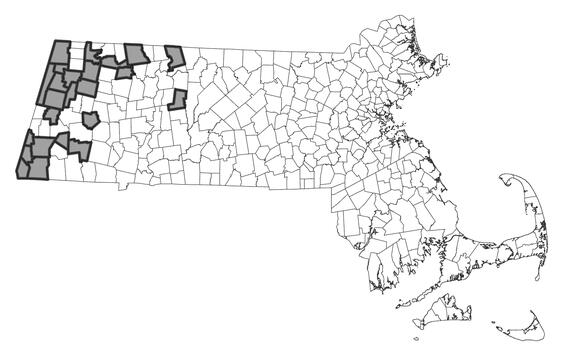- Scientific name: Symphyotrichum prenanthoides (Muhl. Ex Willd.) G.L. Nesom
- Species of Greatest Conservation Need (MA State Wildlife Action Plan)
Description
Crooked-stem aster (Symphyotrichum prenanthoides) is a medium-sized late summer composite wildflower (family Asteraceae) of moist, rich, river- or stream-associated forests, thickets, banks, and meadows. Plants have ascending to erect flexuous stems (20-120 cm; 8-47 in) that change angles at successive nodes in a zigzag like pattern, hence the common name, “Crooked-stem aster.” The alternately arranged spoon-shaped leaf blades narrow at the base then widen slightly to clasp the stem. The lavender-blue flower heads are arranged in a branched inflorescence.
Crooked-stem aster is a colonial plant emerging from long rhizomes. The zigzag stems are glabrous to pubescent, with pubescence found in a line from under the leaves to the next lower node. The stems turn dark purple with age. Most of the lower leaves (6-20 × 1-5 cm; 2.36-7.87 in x 0.39-1.97 in) are oblanceolate, with sharply toothed margins; they taper distally to a sharp point. The leaf base is constricted and auriculate. The upper stem leaves are similar but are less constricted. The inflorescence is broad and branched, with flowering heads on widely spreading to ascending, often purplish branches. The peduncles (~4 cm; 1.6 in) are stiffly pubescent and have small bracts (3-12 mm; 0.12-0.47 in) that segue into the involucre (the whorl of bracts subtending flowers). The flower heads comprise both disk (the tiny regular flowers in the center of the head) and ray florets (the strap-shaped flowers forming the outer whorl of the flower head), the latter with lavender-blue (rarely white) petals. The bell-shaped involucres (5-6 mm; 0.20-0.24 in) have bracts in four to six series, often of different lengths, that are obtuse to acute, and eglandular (without glands). The fruit of crooked-stem aster is a cypsela, which is an achene (dry, single-seeded, indehiscent fruit) that has a modified calyx (pappus) at its apex that is a tuft of fine bristles. This species flowers in late summer into early autumn.
Bristly-aster (Symphyotrichum puniceus) has clasping leaves and purplish flowers; but unlike crooked-stem aster, it has stout reddish, hairy stems, and involucral bracts that are long-acuminate (tapering to a sharp point) to attenuate (tapering to a narrow tip) at the apex, and nearly equal in length. Consulting a technical manual is helpful in differentiating the various species of asters.
Life cycle and behavior

Crooked-stem aster is a perennial species. One plant will have many ramets (individual stems from the same underground rhizome) so a population may look large but only consist of one or a few plants. It blooms starting in August and will continue into late September or early October. This species is self-incompatible, meaning that it needs cross-pollination from an unrelated plant of the same species. When it is growing in large areas, this usually is not a problem, but small patches may only include one plant. It is pollinated by an assortment of bees, including Andrena spp. and Colletes spp., as well as by butterflies and other insects.
Population status
Crooked-stem aster is a species that was delisted from the MESA but remains relatively rare on our landscape. As a species of greatest conservation need, it is maintained on the plant watch list. There are 44 naturally occurring populations of the species verified since 1999 from Berkshire, Hampshire, and Franklin Counties.
Distribution and abundance
Crooked-stem aster is known from Canada (Ontario) to New England, south to North Carolina and Georgia, throughout much of the Midwest to Iowa and Minnesota. In New England, it is possibly extirpated in Connecticut and also occurs in Vermont (not ranked).

Habitat
In Massachusetts, crooked-stem aster occurs on exposed gravelly shores, banks, and open thickets in the rich mesic alluvial soils of river floodplains. It is also found in streamside seeps, partially wooded swamps, and along open to semi-open roadsides. It frequently occurs along trails or small roads where they cross streams or approach floodplains. Associated species include red maple (Acer rubrum), ironwood (Carpinus caroliniana), American elm (Ulmus americana), northern lady fern (Athyrium angustum), common horsetail (Equisetum arvense), white grass (Leersia virginica), and sensitive fern (Onoclea sensibilis). Co-occurring congeners include blue heart-leaf aster (Symphyotrichum cordifolium), calico-aster (S. lateriflorum), tall white aster (S. lanceolatum), and New England aster (S. novae-angliae).
Healthy habitats are vital for supporting native wildlife and plants. Explore habitats and learn about conservation and restoration in Massachusetts.
Threats
This species is threatened by trampling by recreational activities, spread of invasive species, and overshading from nearby plants. As it often grows on stream and river sides, large floods can displace or destroy populations as well.
Conservation
The exact management needs of crooked-stem aster are not known. As with all species, however, maintaining habitat quality is essential. Population locations that receive heavy recreational use (e.g., hiking, ORV) should be carefully monitored for plant damage or soil disturbance; trails can sometimes be re-routed to protect the rare plant population; however, this species does need some disturbance to keep its habitat open. Crooked-stem aster habitat should also be monitored for competition and over-shading by aggressive native and exotic invasive plants; aggressive native and exotic plants can out-compete rare plants for nutrients and block light, excluding them over time. Some invasive species, such as garlic mustard (Alliaria petiolata) are allelopathic, meaning they can change the soil chemistry to inhibit the viability of native plants. Exotic species of concern in plant communities supporting crooked-stem aster are garlic mustard, Asiatic bittersweet (Celastrus orbiculatus), morrow honeysuckle (Lonicera morrowii), and multiflora rose (Rosa multiflora). If exotic plants are invading crooked-stem aster habitat, a plan for control should be constructed.
Contact
| Date published: | May 7, 2025 |
|---|